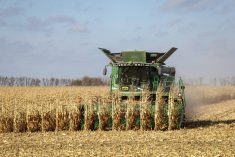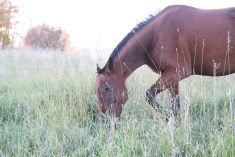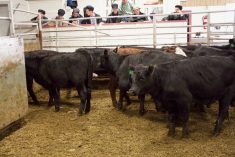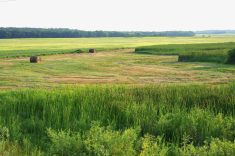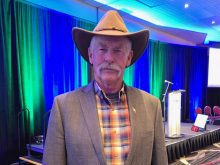One Interlake farm family is developing a rubber management strategy — one that bounces back in wet times or dry — for dealing with weather extremes.
Don Green even joked about the new “Interlake cowboy boot,” made of rubber of course, as he shared his approach to dealing with the wet cycle of the past three years.
The Fisher Branch rancher said his family farm has switched to growing perennial forages better adapted to a variety of growing conditions, feed testing supplies, and developing a more flexible harvest system, which is a plan he thinks might also stand the farm in good stead when the dry times inevitably return.
Read Also

Local farm businesses, groups look forward to Manitoba Ag Days 2026
Most of agriculture is seemingly at Manitoba Ag Days each January: Manitoba agribusinesses and farm groups look forward to connecting with farmers at the 2026 show.
“Flexibility is key,” he said, during a session at Manitoba Grazing School 2011. “It can be wet or it can be dry. We have no idea what the future holds.”
Green’s G7 Ranch includes a cow-calf operation of 1,000 cows with calves backgrounded on homegrown forage rations.
Perennial forages have been the mainstay for producing feed for their cattle, but with their main hay crop, alfalfa pretty much gone, they’ve had to make up for that loss in their hay and pasture stands.
That’s meant tweaking their forage mixes to adapt to the wetter conditions. They’ve made some discoveries along the way.
They found that tall fescue seeded not only tolerated flooded fields and salinity, but reseeded itself in wet conditions, Green said. Now, thick and vigorous stands exist where alfalfa, brome and even timothy disappeared.
“It just kept getting thicker and thicker through the wet conditions. So that was nice.”
They also saw thriving volunteer stands of alsike clover develop, and have now added it at a small inclusion rate (10 per cent for hayfields and 20 per cent in pastures).
“We consider it a substitute for alfalfa in the low-lying areas,” Green said.
Haying season was another challenge. Seeking alternatives to putting up dry hay, they bought a self-loading forage wagon which allowed them to put up silage even in very wet weather.
“It’s been a very effective tool,” he said. He’s done cost comparisons and “it’s probably as cheap per ton as baling,” he added.
Meanwhile, making feed with decimated forage quality was another major issue to deal with the last three years.
“I was shocked when we got our feed tests back (in 2010),” Green said. “Our best hay in 2010 was worse than our timothy straw in 2011, that’s what we were dealing with.”
Supplementation has been critical, and for that they’ve used barley, forage and hemp screenings, grain screening pellets and DDGs, he said.
Other speakers described broadcast seeding, using crops such as annual ryegrass seeded with barley and oats, greenfeed for fall grazing, winter-sown annuals, and cover crops with legumes for soaking up excess moisture as well as fixing nitrogen.
Tim Clarke, a livestock and forage specialist with MAFRI who also farms in the northwest Interlake, said they’ve been left with about half as many acres in alfalfa as they had in 2008. He made a management decision to try and grow as many tons of alfalfa off the remaining acres by fertilizing heavily, he said.
Clarke added he’s been impressed with what annual ryegrass does in a wet fall.
Cut in early August in 2010 and rained on throughout the rest of that month and into September, it had excellent regrowth, Clarke said.
“It grew between 10 and 18 inches in 35 days that fall. So we got quite a bit of fall grazing out of it.”
Interestingly, Clarke added, for all their struggles and deliberations these past three years dealing with wet conditions, the north Interlake is actually more prone to drought, with hay shortages usually resulting from dry rather than wet conditions.
That was a point made by another grazing school speaker, who said, hard as it is to believe in years like we’ve seen recently Western Canada is still a semi-arid area.
Over the longer term, average annual precipitation has not kept up with average annual evaporation, said Paul Bulloch, a University of Manitoba professor in the department of soil science.
The region is currently experiencing an extreme weather cycle and these extreme fluctuations call for different crop management options and strategies, Bulloch said.
Things could be worse, and they have been. There is evidence of droughts in this part of the world lasting 20 and 30 years.
“We’ve had cycles in the past, going back a long ways,” he said. “The message from the distant past is perhaps even more disturbing than what we’re facing right now.”



